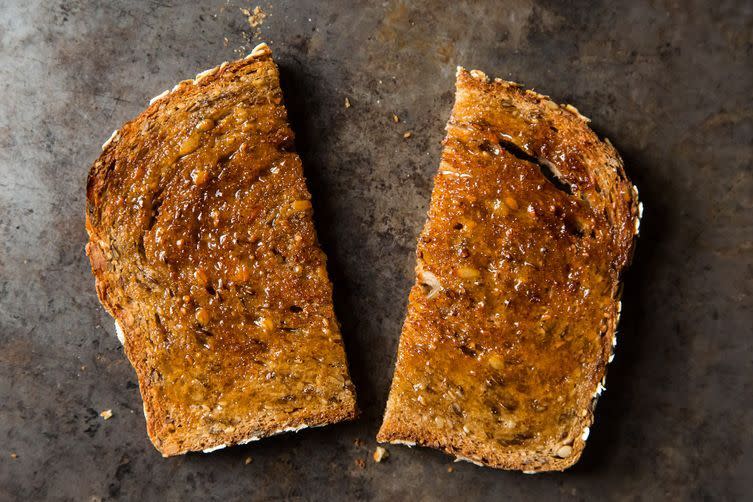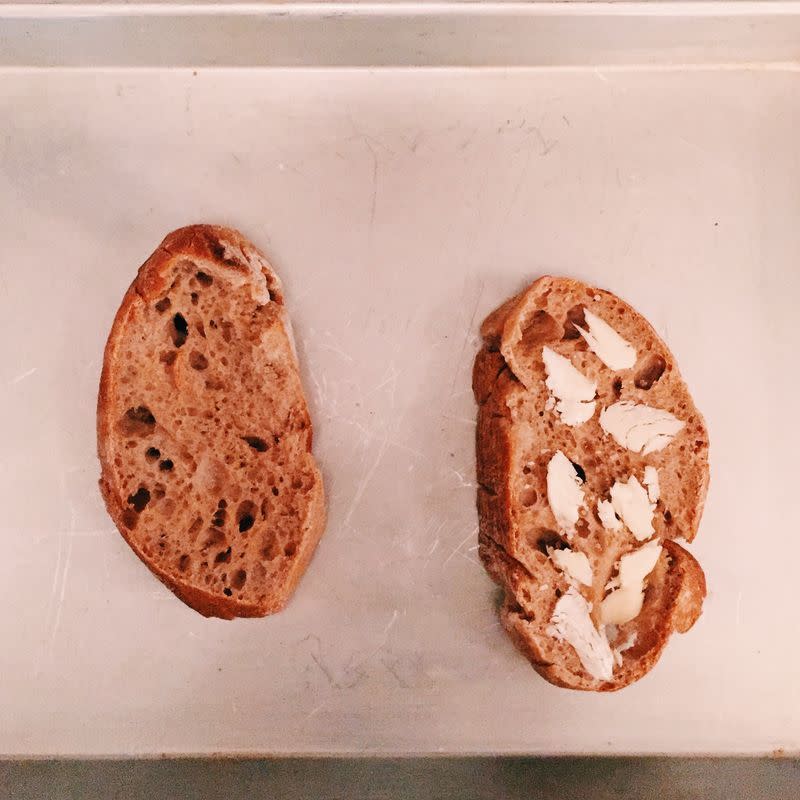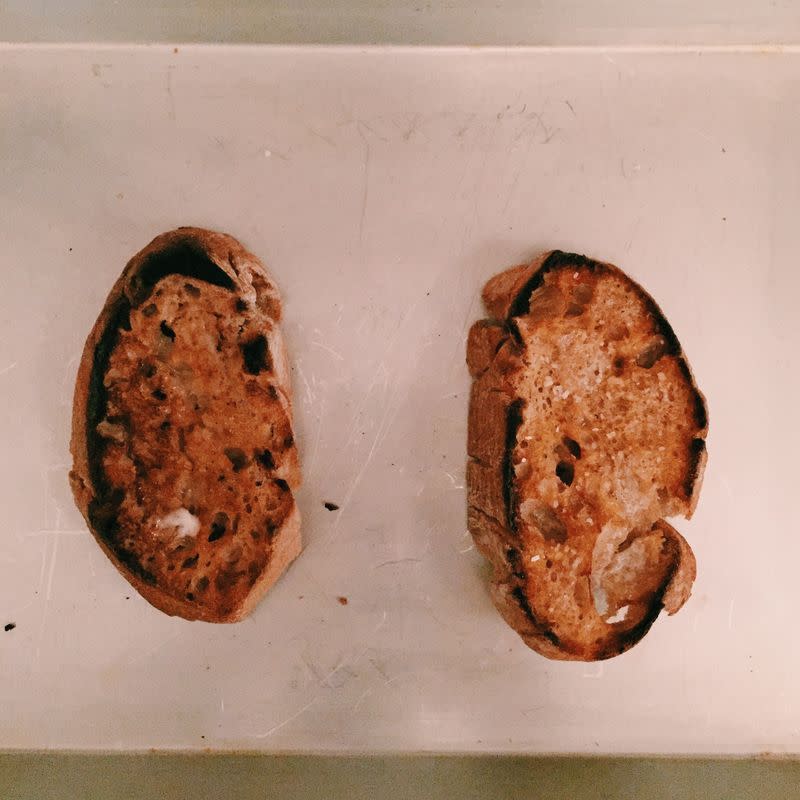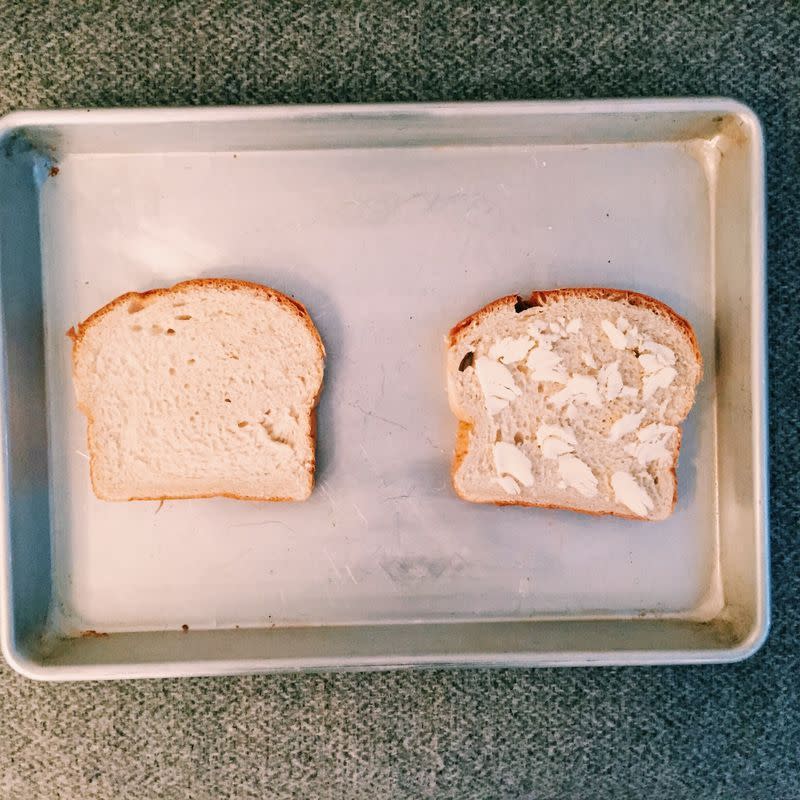How to Butter Your Toast (Because You’ve Been Doing It Wrong)
Have I been making toast the wrong way my whole life?
It’s a disturbing thought, but one I had to face as I watched Raquel Pelzel demonstrate how to make the cinnamon toast from her book Toast. Instead of buttering the bread after toasting it (a logical order I’ve followed by whole life), Raquel butters the bread before.

This right here is a photograph of the Platonic toast. (Photo: Ryan Dausch)
Raquel explained her toast approach in an email:
I like to butter/oil bread before toasting (and salt it, too!) because the bread absorbs the fat—it seeps down into the crumb. After toasting (broiler/grill pan/grill/skillet), the top layer of the toast takes on a glowy/caramelized sheen and a crispness that is so good. Plus all the sugars in the butter caramelize a little.
Related: Fried Toast & 7 Ways it Can Bring You Joy
Bite into the toast and the top layer of bread shatters and then gives way to this more tender—yet still flavorful due to the sponge-like absorption of fat—interior layer.
Related: 8 Savory Breakfast Toasts

Maple cinnamon toast. (Photo: James Ransom)
Raquel is convincing, but still I was skeptical, so I asked the Food52 staff about their butter routines.
Related: 3 Ways to Make Toast without a Toaster
Lauren said her grandmother buttered her bread pre-toasting but that she had no idea why; Catherine said she pre-butters when she’s toasting in the oven; and Jeremy put us all to shame: He does a light toast, then adds butter and toasts some more.
But the most adamant butter-before-toasting advocate was Amanda, who even drew a diagram to explain its magic.
Related: 5 Variations on Avocado Toast

In Amanda’s drawing, the pats of cold butter melt into the bread in the oven, creating “butter puddles" outlined by "burned bridges.” (Photo: Sarah Jampel; Illustration: Amanda Sims)
Related: 10 Ways to Have Toast for Dinner
The Taste Tests
1. I tried my experiment first with some bread that the nice people from Le Pain Quotidien had baked at our office earlier that day (yes, we’re spoiled!).


Pre-buttered (left) and post-buttered (right). (Photos: Sarah Jampel)
In the photo on the left, you see the slices of bread, pre-broil. On the right, you see the bread out of the oven. The pre-buttered bread was barely lighter in color with no other distinguishable features.
When I asked Amanda and Kristen to taste the toasts and guess which was which, both of them chose wrong!
Related: 5 Desserts Made with Cinnamon Toast

Pre-buttered (left) and post-buttered (right). (Photo: Sarah Jampel)
2. For test two, I tried with a more traditional sandwich bread, hoping the results would be more obvious.

Buttered after toasting (left) versus buttered before toasting (right). (Photo: Sarah Jampel)
And they were! The pre-buttered bread was much ligher in color, mottled with the very “butter puddles” Amanda Sims had described. It had a richer butter flavor (though, admittedly, I might have applied more butter to this piece) and, with airier innards, a generally more tender texture.
The piece that I buttered post-toasting deflated as I used the knife to rub in the cold butter (which, even against the warm bread, needed assistance melting).
Moreover, spreading on the butter picked up all sorts of burnt and browned crumbs, which contaminated the whole stick of butter (and that’s going to keep this neat freak up tonight).

Buttered after toasting (left) versus buttered before toasting (right). (Photo: Sarah Jampel)
So, yes: Raquel, and Lauren Locke’s grandma, and Amanda Sims, and a whole host of others are onto something.
The advantages of buttering your bread before toasting:
You don’t have to struggle with spreading the butter; simply dab it all over the surface and let the heat of the oven work its magic
You’ll probably unknowingly apply more butter than you might otherwise, which will make your toast taste better
No messy crumbs in the butter
Tender butter patches on the bread’s surface, interrupted by burnished areas where the butter did not reach
Richer infusion of fatty flavor
But be warned: Don’t try this in a pop-up toaster! Raquel cautions that it might cause a grease fire. Pre-buttered toast is so good, however, that we might just have to try this sideways trick from Lifehacker.

Toast scraps. (Photo: Sarah Jampel)
By Sarah Jampel.

